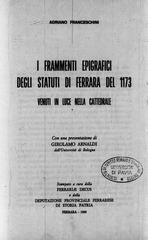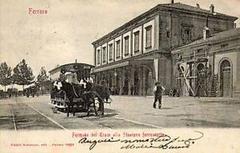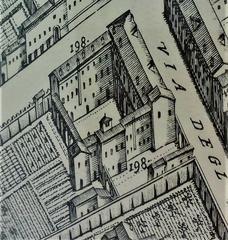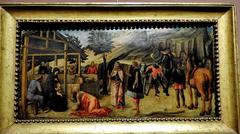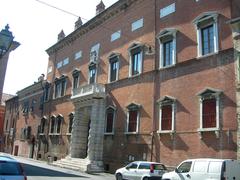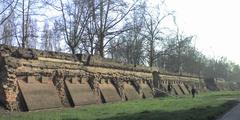Corpus Domini Monastery Ferrara Italy: Visiting Hours, Tickets, and History Guide
Date: 04/07/2025
Introduction
Nestled in Ferrara’s medieval heart, the Corpus Domini Monastery is a rare convergence of religious devotion, Renaissance artistry, and dynastic history. Founded in 1406 by Bernardina Sedazzari as a Poor Clares convent, and later supported by the influential Este family, the monastery has evolved into one of Ferrara’s most compelling historical and cultural sites. Today, it stands as both an active monastic community and a living museum, renowned for its serene cloisters, Baroque interiors, and its role as the final resting place for members of the Este dynasty, including Lucrezia Borgia and Eleonora d’Aragona. This guide presents the history, architectural highlights, spiritual significance, and practical information needed to plan your visit, including up-to-date visiting hours, ticketing details, accessibility, and nearby attractions. (Comune di Ferrara, Visit Ferrara, Ferrara Terra e Acqua, Pro Loco Ferrara)
Table of Contents
- Historical Overview
- Architectural and Artistic Features
- Religious and Cultural Significance
- Visiting Information
- FAQs
- Plan Your Visit & Contact
- References
Historical Overview
Foundation and Early History
Founded in 1406 by Bernardina Sedazzari, the Corpus Domini Monastery began as a Poor Clares convent, embracing the ideals of poverty, humility, and contemplation. The monastery’s foundation aligned with a broader movement of female monasticism in Italy, often supported by local nobility seeking spiritual merit. The Este family, Ferrara’s ruling dynasty, soon became its principal patron, intertwining the monastery’s fate with the city’s political and cultural development. (Comune di Ferrara)
Renaissance Patronage and the Este Dynasty
Under Este patronage, Corpus Domini became a spiritual and dynastic center. By the mid-15th century, it housed several noblewomen, including members of the Este lineage. The Este family’s support enabled architectural and artistic enhancements—Renaissance frescoes, a serene cloister, and a public church—while also transforming the monastery into their dynastic mausoleum, where figures such as Lucrezia Borgia and Eleonora d’Aragona are buried. (Ferrara Terra e Acqua, Visit Ferrara)
Religious Life and Social Influence
Corpus Domini was more than a place of worship; it was a refuge for noblewomen and a center for charity and education. The convent maintained a scriptorium and contributed to Ferrara’s intellectual and spiritual life. Its nuns, the Poor Clares, lived by strict Franciscan principles, fostering a reputation for spiritual retreat and contemplation. (Vatican News)
Architectural Evolution and Artistic Heritage
The monastery’s architecture blends an austere terracotta façade with a richly decorated Baroque interior. Expansions in the 17th and 18th centuries introduced marble, gilded stuccoes, and monumental frescoes, with the ceiling painting “Glory of Saint Catherine Vegri” by Giuseppe Ghedini as a highlight. The choir houses the Este tombs, marked by simple stone slabs reflecting the Poor Clares’ humility. (inferrara.it)
Preservation and Modern Times
Despite periods of suppression—most notably during the Napoleonic era—the monastery has survived, thanks to restoration and the ongoing presence of the Poor Clares. It is now part of the UNESCO-listed historic center of Ferrara, recognized for its cultural and historical significance. (UNESCO)
Architectural and Artistic Features
Exterior Façade and Gothic Portal
The monastery’s façade on Via Campofranco is constructed from Ferrara terracotta, with a Gothic portal and rose window that evoke its 15th-century origins. Decorative elements salvaged from earlier structures maintain a tangible link to the Renaissance period. (inferrara.it, rutaborjaborgia.com)
Interior Layout and Baroque Renovation
Inside, the monastery features a modest, contemplative nave and a separate nuns’ choir, emphasizing the Poor Clares’ seclusion. The Baroque renovation added gilded stuccoes, elaborate frescoes, and an ornate high altar, creating a spiritually uplifting atmosphere that contrasts with the exterior’s simplicity. (wikipedia.org)
Ceiling Fresco: “Glory of Saint Catherine Vegri”
Painted by Giuseppe Ghedini (1770–1773), this ceiling fresco depicts Saint Catherine of Bologna in celestial glory, surrounded by angels. It is a masterpiece of late Baroque religious art, commemorating the monastery’s most revered resident. (wikipedia.org, rutaborjaborgia.com)
High Altar and Liturgical Furnishings
The high altar features “Communion of the Apostles,” a dramatic oil painting by Giambettino Cignaroli (1768). The church is further adorned with intricate woodwork, polychrome stuccoes, and preserved liturgical objects linked to the Este family and Saint Catherine. (wikipedia.org, inferrara.it)
Este Family Tombs
The nuns’ choir contains the tombs of Lucrezia Borgia, Alfonso I d’Este, Eleonora d’Aragona, and other Este princes and princesses. Their simple markers reflect monastic humility, while their historical importance draws pilgrims and scholars from around the world. (rutaborjaborgia.com, inferrara.it)
Cloister and Gardens
The tranquil cloister, with its harmonious proportions and peaceful garden, remains central to monastic life. While access is limited, its presence enhances the contemplative atmosphere of the site. (thetouristchecklist.com)
Religious and Cultural Significance
The Poor Clares and Spiritual Life
Since its foundation, the monastery has housed a continuous community of Poor Clares. Their daily rhythm of prayer and seclusion, focused on the Eucharist, imbues the site with spiritual serenity. The monastery’s name, “Corpus Domini,” underscores this central devotion. (Vatican News)
Burial Site of the Este Family
The monastery’s role as the Este family’s dynastic mausoleum elevates its historical and cultural status. Burial sites for Lucrezia Borgia, Alfonso I d’Este, and related Este women who became nuns, such as Eleonora d’Este, reinforce the deep connection between the convent and Ferrara’s ruling elite. (Museo Ferrara)
Legacy of Saint Catherine of Bologna
Saint Catherine of Bologna, who lived at Corpus Domini until 1456, was a spiritual leader and artist. Her illuminated breviary and lost frescoes once enriched the convent’s walls. The annual commemoration of her “miracle of the bread” on March 9, when the “miracle oven” is displayed, remains a spiritual highlight. (Pro Loco Ferrara)
Pilgrimage and Community Engagement
Corpus Domini is a focal point for local devotion and pilgrimage, especially during the feast of Corpus Christi and the annual celebration of Saint Catherine’s miracle. The nuns engage with visitors through guided tours and events, balancing their cloistered life with Ferrara’s cultural tourism. (Visit Ferrara)
Visiting Information
Visiting Hours and Tickets
- Visiting Hours: The monastery is generally open Tuesday to Sunday, with hours varying depending on season and special events. Typical hours are 10:00 AM – 5:00 PM, closed on Mondays and public holidays. Guided tours may be required for access.
- Tickets: Admission fees typically range from €7–€8 for adults, with reductions for students, seniors, and Ferrara residents. Children under 12 often enter free. Tickets can be purchased online or at the entrance. Booking ahead is recommended, especially during festivals or high season.
Guided Tours and Accessibility
- Guided Tours: Multilingual guided tours are available by advance reservation and are strongly recommended to fully appreciate the monastery’s art and history.
- Accessibility: Most public areas are wheelchair accessible, though historic sections and the cloister may have limitations. Visitors with mobility needs should contact the administration in advance to arrange assistance.
Visitor Etiquette and Facilities
- Etiquette: Modest dress and respectful behavior are required. Maintain silence in sacred areas and follow photography restrictions, especially near tombs and in the choir.
- Facilities: No cafés or shops are within the monastery. Dining and shopping options are plentiful in the surrounding historic center. Restroom facilities are limited.
Nearby Attractions
- Este Castle (Castello Estense): A Renaissance fortress and symbol of Ferrara, just a 10-minute walk away.
- Palazzo dei Diamanti: Home to the National Picture Gallery, a 20-minute walk from the monastery.
- Ferrara Cathedral: A major Romanesque-Gothic monument, located 15 minutes away on foot.
- Basilica di San Francesco and Palazzo Romei: Nearby historical sites that complement a visit to Corpus Domini.
FAQs
Q: What are the current visiting hours?
A: The monastery is generally open Tuesday to Sunday, 10:00 AM–5:00 PM. Special events and guided tours may affect access; always check official sources for up-to-date information.
Q: How do I purchase tickets?
A: Tickets are available online via the official Ferrara tourism website or at the entrance. Guided tours may require advance booking.
Q: Is the monastery accessible for wheelchair users?
A: Most areas are accessible, but some historic spaces may be limited. Contact the administration ahead of your visit for details.
Q: Are guided tours required?
A: In most cases, access is only through guided tours to preserve the cloistered community’s privacy and the site’s integrity.
Q: Can I take photographs?
A: Photography is permitted in public areas, but restrictions apply in the choir, cloister, and near tombs to protect artworks.
Plan Your Visit & Contact
- Address: Via Campofranco, Ferrara, Italy
- Reservations and Information:
- Pro Loco Ferrara
- Email: [email protected]
- Phone: +39 347 4265649
- Official Websites:
Summary and Call to Action
The Corpus Domini Monastery embodies centuries of faith, art, and dynastic memory at the heart of Ferrara. Its austere façade, Baroque interiors, and Este tombs offer a profound journey through Renaissance Italy’s religious and cultural tapestry. As an active convent, it balances monastic tradition with public engagement through guided tours and cultural events. Its proximity to other top Ferrara historical sites makes it an essential stop for visitors seeking to immerse themselves in UNESCO-listed heritage.
To enrich your experience, download the Audiala app for expert audio guides, interactive maps, and up-to-date visitor information. Stay informed about events and travel tips by following our social media channels and exploring related articles on Ferrara’s rich cultural legacy.
References
- Comune di Ferrara
- Ferrara Terra e Acqua
- Visit Ferrara
- UNESCO
- Inferrara.it
- Rutaborjaborgia.com
- Wikipedia
- Museo Ferrara
- Vatican News
- Pro Loco Ferrara
- The Tourist Checklist
